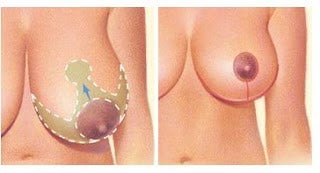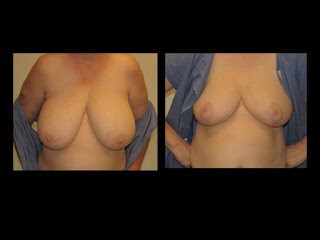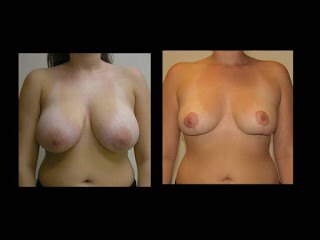How do you decide what size to be after breast reduction surgery?
6/3/2016
Women who choose to have breast reduction surgery are typically extremely happy with the results. Most patients feel that they are much more comfortable, fit in clothes better, and can exercise much more easily. For all these reasons, the patient often sees tremendous gains in self-esteem, fitness, health, and appearance.
Choosing a size after surgery depends on each patient's goals, desires, starting size and shape.

For example, a young, fit woman who is an active athlete who is a D cup starting out, may wish to be a small B cup afterward. And this may suit her frame and sports endeavors. This breast size after surgery may be inappropriate, indeed impossible, for a patient with a much larger size and significant skin droop. For many patients who are exceptionally large, anything smaller than what they have is an improvement, even if that means ending up a D or DD cup size.

It is difficult to predict cup sizes after surgery for a number of reasons. Bra cup sizes are not standardized between manufacturers, so a C cup in one company may be a D in another. So instead of focusing on cup sizes, most plastic surgeons consider skin measurements in centimeters as a better way to size patients. We measure from the base of the neck (what we call the "sternal notch" to the nipple distance). We then measure from the nipple to the bottom of the breast- the "inframammary fold". Now we have real numbers to compare among patients.
Regardless of a patient's height or weight, we find that as long as the nipple height is near the height of the inframammary fold, and the distance from the nipple to the fold is not more than 10-12cm, then patients are pretty comfortable with their breast size. With these measurements, a woman's bra straps do not have to work very hard to keep the breast in a centered position. We would rarely see such measurements in patients seeking reduction surgery unless they were in the active athlete category and wanted the benefit of a smaller size so they could more easily take part in their profession or hobby, such as tennis, gymnastics, golf, or running. ( The "sports reduction", as I call it, is a fantastic procedure in the right patient).
So if, for example, a patient comes into the office with a starting breast measurement of 35 cm nipple to neck, and 15 cm to the fold under the breast, then we can be VERY sure that our final result will be MUCH more comfortable. If we raise the nipple height to the level of the fold under the breast (24 cm is likely in this patient) and define a distance from the nipple to the fold of 8 cm, then in most cases, this patient will be a small D cup after surgery. For a very wide and heavier patient, the bra size may still be a DD, though a more slender patient may end up with a C cup with these same measurements. but most all patients will end up very happy!

(Dr. Suzman Breast Reduction Patient with 35 cm nipple to sternal notch distance and 15 cm to inframammary crease(left) and result after reduction surgery 24 cm/8cm)
For patients who want to be significantly smaller-- some just have suffered too long with very large breasts and want to be as small as possible-- more tissue can be removed to make a smaller size. In a larger, heavier patient, this means that the breast will be quite flat and not at all "perky". Perkiness is not typically a concern of such patients who just want comfort. For smaller and more petite patients who want a very small breast size, this can also be accomplished with breast reduction surgery, though they do run an increased risk of numbness or inability to breastfeed after surgery. Each patient must balance these pluses and minuses of surgery to make the best decision for themselves.
On realself.com, an online website devoted to patients interested in plastic surgery procedures, over 98% of patients say going through breast reduction surgery was worth it. This is a very high number for a surgical procedure!
At our WESTMED plastic surgery practice, I personally perform about 2 breast reductions a week, so it is a very common surgery. If you want to learn more about breast reduction or our "sports reduction", come and meet us in person in our Westchester office (Only 30 minutes from Manhattan NYC) or our Greenwich CT office.
Learn More about Breast Reduction Risks and Benefits

Dr. Suzman Sports Breast Reduction from D cup to B cup bra
Dr. Michael Suzman is one of the country's busiest plastic surgeons who has been honored to have patient satisfaction rates in the top 1% of doctors in the country according to the Press Gainey Survey.
New York Magazine, U.S. News and WORLD report and Westchester magazine have all listed him as a top doctor for Plastic Surgery.
Breast reduction surgery involves many choices. The first and most important is selecting a member of the American Society of Plastic Surgeons (ASPS) surgeon you can trust.
Dr. Suzman recommends RescueMD skin recovery gel for treatment of incisions and scars after surgery.
Do not be confused by other official sounding boards and certifications.
The ABPS is recognized by the American Board of Medical Specialties (ABMS), which has approved medical specialty boards since 1934. There is no ABMS recognized certifying board with “cosmetic surgery” in its name.
By choosing a member of the American Society of Plastic Surgeons, you can be assured that you are choosing a qualified, highly trained plastic surgeon who is board-certified by the ABPS or The Royal College of Physicians and Surgeons of Canada.